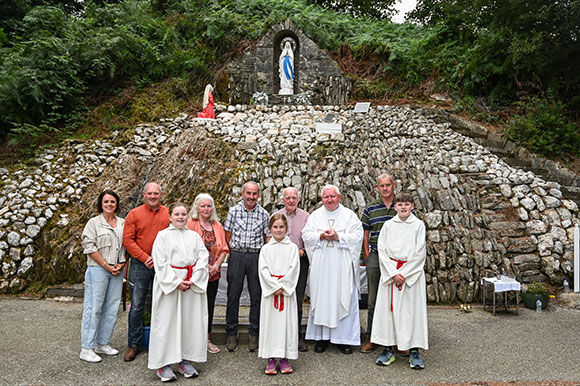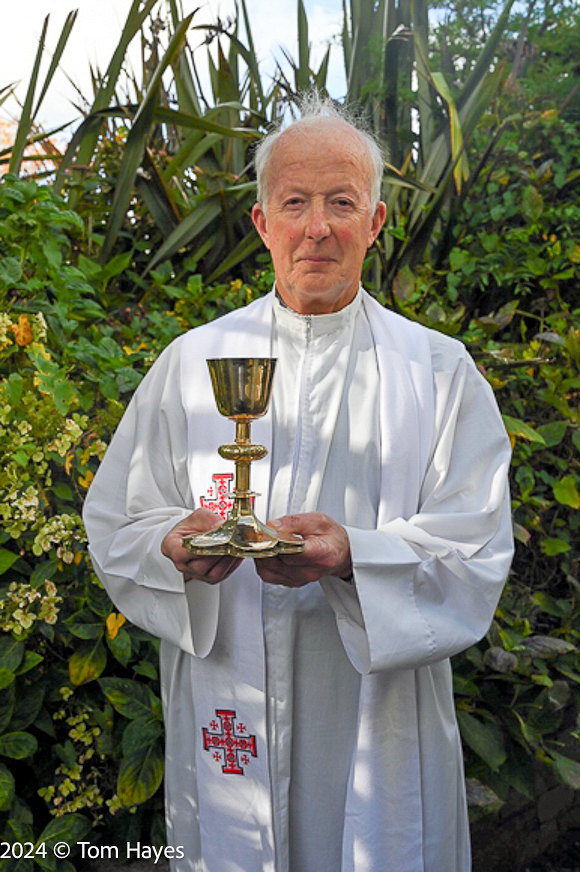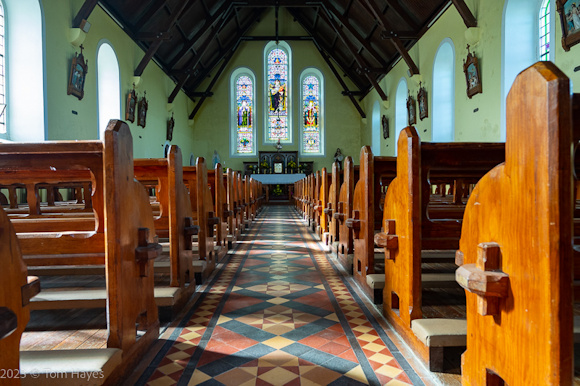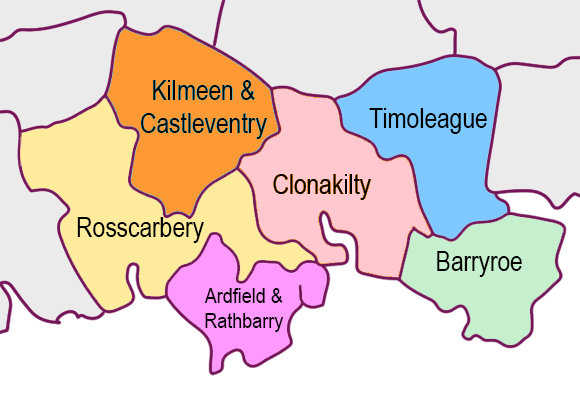Stories from the Family of Parishes
Receive Stories, Reflections and Notices direct to your email
Each of the churches in our family of parishes has its own story and its own architectural and artistic treasures. These were commissioned to point the congregations as well as the casual visitor to the glory of God
St. James Church, Ardfield, was erected in 1832, just a few years after Catholic Emancipation. However, much of its artistic decoration dates from almost a century later.
The stained glass windows in the church were made by Watsons of Youghal. The work of this Cork firm can be found in many Co Cork churches.
The two Ardfield windows to the left and right of the altar are excellent examples of Watsons’ adaptation of the Celtic motifs and tracery from the Book of Kells and other Irish sources.
The window of the Sacred Heart was donated, the window says, by Mrs Galway (probably Galwey). The window of Our Lady of the Immaculate Conception was donated by Miss Walsh.
Watsons commenced making windows in Youghal in the 1880s but the Celtic Revivalist style of windows was moslty used by them in the 1900s.
The next time you atre passing St. James’ Church in Ardfield, do have a look at the windows and also look out for Watsons window which depicts the patron of the church.
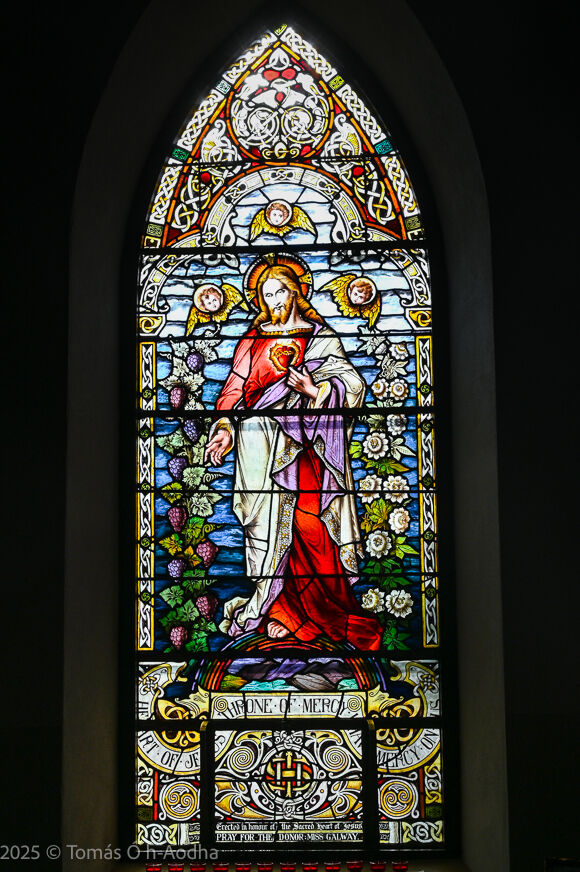 Sacred Heart Window
Sacred Heart Window
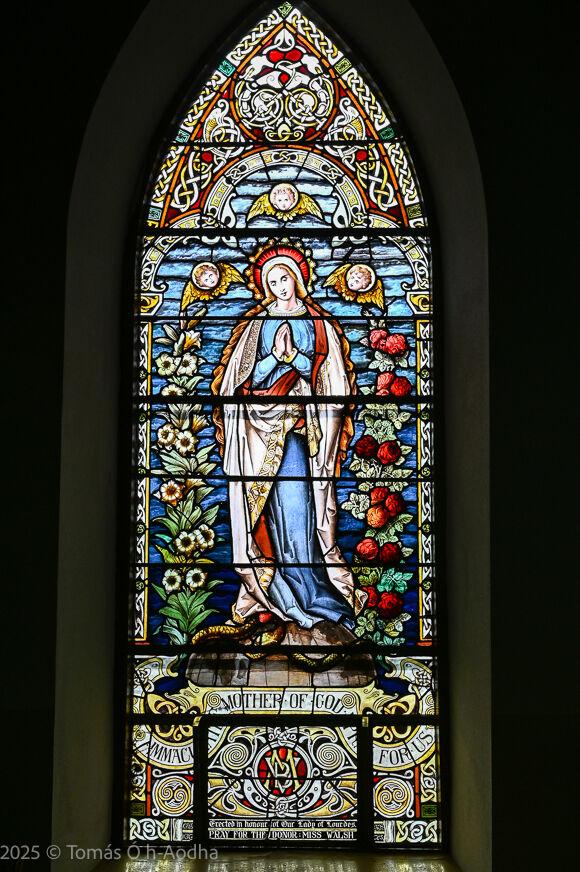 Window of Our Lady of the Immaculate Conception
Window of Our Lady of the Immaculate Conception
The Grotto to Our Lady at Bealad, in the Parish of Killmeen and Castleventry, is on a busy road
Countless people drive past it every day – many blessing themselves as they do and asking the protection of Our Lady on their journeys.
The grotto is cared for by a small group of local parishioners who also organise the annual Mass at the Grotto to mark the Feast of the Assumption on August 15th
The Schools' Collection in Ireland was primarily compiled between 1937 and 1939
It was a folklore collecting project organised by the Irish Folklore Commission.
One of the entries deals with the tradition of the Holy Well at Castleventry, Rossmore.
Written by Willie Coghlan, Clashatarrif, Rossmore it reads:-
“There are many holy wells in this country. There is one in Castleventry. It is beside the graveyard. It is like an ordinary well. It is round and a flat stone covers it. The well is not a deep one. It is said that there is a cure in the water of this well. It is said that sight was restored to a person who lived in the same townland long ago. It is sometimes called Trinity Well. Many people visit it on Trinity Sunday. They bring flowers or other things to the well. They also pray at this time.
 Gathering at the Holy Well dedicated to the Holy Trinity at Castleventry, Rossmore.
Gathering at the Holy Well dedicated to the Holy Trinity at Castleventry, Rossmore.Documentary evidence places the foundation of the Friary at Timoleague between 1307 and 1316
Though physical evidence suggests that a pre-existing 13th century building was incorporated into the site. According to the Annals of the Four Masters, the Friary was founded by the McCarthy Reagh family in 1240.
By the 15th Century the Friary was recognised as a significant place of learning. Blessed Thaddeus McCarthy Reagh (1455-29/10/1492) is said to have been educated by the Friars of Timoleague. Despite the dissolution of the monasteries in 1540 by Henry VIII, the Friars remained in Timoleague.
In 1642 Timoleague Friary was burned by crown forces. Some friars escaped by rowboat heading west to Sherkin Island, where there was also a friary, to take refuge with their brothers. They were rescued by fishermen from Cape Clear, who saw their boat drifting at sea. They found three friars in the boat, two were dead and the third utterly exhausted. He left a box in the custody of the people of the house until his return, but he never came back.
In 1855 the Parish Priest, Fr. Henry Leader, was visiting Cape, and spotting the box, enquired as to its history and to what it contained. As the family were instructed by the Friars, it had never been opened in over 200 years. So, the Priest gave instructions to open it; it contained the remains of vestments, and also a chalice that had been made in London in 1633. It was returned to Timoleague Parish and is known as the Timoleague Chalice.
In October 2024, it was used at Mass by the priests of the Diocese of Cork and Ross during their annual priests’ retreat.
The youngest church in the parish of Rosscarbery has an art treasure at its centre
Carraigfada Church, dedicated to St. Peter, was opened on Sunday 21st November 1909, by Most Rev Denis Kelly, Bishop of Ross. The first Mass was celebrated by Rev Peter Hill PP VF. The first curate was Fr Jeremiah O’Driscoll.
Fr. Peter Hill was largely responsible for the building of the church. His nephew, of the same name, was responsible for the building of Timoleague Church in 1912. Soon after the dedication of Timoleague Church, Fr. Hill was transferred to Rosscarbery to replace his uncle who died that year.
In December 1921, he was transferred to Clonakilty and was appointed Vicar General (VG) of the Diocese of Ross. But he was still to leave his mark on Carraigfada Church in the wonderful three-light stained glass window in the sanctuary.
How the Parish got the name Barryroe
The history of the name Barryroe for the Parish is quite complicated. To summarise, ‘Barry’ has its roots in the lands under the patronage of Saint Barruch being given to a Norman (therefore French) military clan calling themselves the people of Barruch i.e. de Barri. The ‘Roe’ part refers to Lawrence Barry (c. 1400) who was named Red Barry possibly because he had a red complexion or even red hair? Ruadh is Irish for Red so Barra Ruadh or Barraí Rua anglicised became Barryroe.
The Parish includes townlands such as of Abbeymahon, Ardgehane, Ballycremond, Butlerstown, Carrigeen, Courtmacsherry (where Courtmacsherry Church is), Donaghmore, Dunworly, Grange More/Beg, Lehenagh, Lislevane, Shanaghobarravane, Ternanean (where Barryroe Parish Church is).
There are two Churches in the Parish:
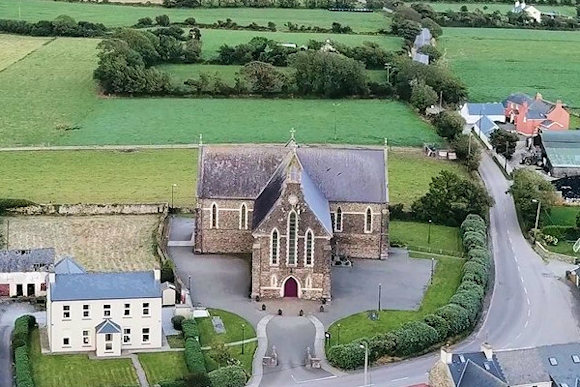 Church of Our Lady, Star of the Sea - Barryroe
Church of Our Lady, Star of the Sea - Barryroe
 Sacred Heart Church - Courtmacsherry
Sacred Heart Church - Courtmacsherry
Search
Receive Notices and Reflections direct to your email
Emergency Phone
Contact a Priest
086 876 0608
for urgent calls only

